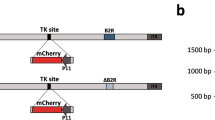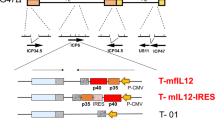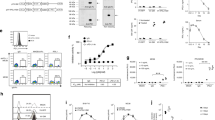Abstract
Semliki Forest virus (SFV) represents a promising gene therapy vector for tumor treatment, because it produces high levels of recombinant therapeutic proteins while inducing apoptosis in infected cells. In this study, we constructed a SFV vector expressing murine interferon alpha (IFNα). IFNα displays antitumor activity mainly by enhancing an antitumor immune response, as well as by a direct antiproliferative effect. In spite of the antiviral activity of IFNα, SFV–IFN could be produced in BHK cells at high titers. This vector was able to infect TC-1 cells, a tumor cell line expressing E6 and E7 proteins of human papillomavirus, leading to high production of IFNα both in vitro and in vivo. When injected into subcutaneous TC-1 tumors implanted in mice, SFV–IFN was able to induce an E7-specific cytotoxic T lymphocyte response, and to modify tumor infiltrating immune cells, reducing the percentage of T regulatory cells and activating myeloid cells. As a consequence, SFV–IFN was able to eradicate 58% of established tumors treated 21 days after implantation with long-term tumor-free survival and very low toxicity. SFV–IFN was also able to induce significant antitumor responses in a subcutaneous tumor model of murine colon adenocarcimoma. These data suggest that local production of IFNα by intratumoral injection of recombinant SFV–IFN could represent a potent new strategy to treat tumors in patients.
This is a preview of subscription content, access via your institution
Access options
Subscribe to this journal
Receive 12 print issues and online access
$259.00 per year
only $21.58 per issue
Buy this article
- Purchase on Springer Link
- Instant access to full article PDF
Prices may be subject to local taxes which are calculated during checkout






Similar content being viewed by others
References
Isaacs A, Lindenmann J . Virus interference. I. The interferon. Proc R Soc Lond B Biol Sci 1957; 147: 258–267.
Gresser I, Bourali C, Levy JP, Fontaine-Brouty-Boye D, Thomas MT . Increased survival in mice inoculated with tumor cells and treated with interferon preparations. Proc Natl Acad Sci USA 1969; 63: 51–57.
Sangfelt O, Erickson S, Castro J, Heiden T, Einhorn S, Grander D . Induction of apoptosis and inhibition of cell growth are independent responses to interferon-alpha in hematopoietic cell lines. Cell Growth Differ 1997; 8: 343–352.
Thyrell L, Erickson S, Zhivotovsky B, Pokrovskaja K, Sangfelt O, Castro J et al. Mechanisms of interferon-alpha induced apoptosis in malignant cells. Oncogene 2002; 21: 1251–1262.
Sidky YA, Borden EC . Inhibition of angiogenesis by interferons: effects on tumor- and lymphocyte-induced vascular responses. Cancer Res 1987; 47: 5155–5161.
Indraccolo S . Interferon-alpha as angiogenesis inhibitor: learning from tumor models. Autoimmunity 2010; 43: 244–247.
Swann JB, Hayakawa Y, Zerafa N, Sheehan KC, Scott B, Schreiber RD et al. Type I IFN contributes to NK cell homeostasis, activation, and antitumor function. J Immunol 2007; 178: 7540–7549.
Curtsinger JM, Valenzuela JO, Agarwal P, Lins D, Mescher MF . Type I IFNs provide a third signal to CD8 T cells to stimulate clonal expansion and differentiation. J Immunol 2005; 174: 4465–4469.
Dondi E, Roue G, Yuste VJ, Susin SA, Pellegrini S . A dual role of IFN-alpha in the balance between proliferation and death of human CD4+ T lymphocytes during primary response. J Immunol 2004; 173: 3740–3747.
Kirkwood JM, Bender C, Agarwala S, Tarhini A, Shipe-Spotloe J, Smelko B et al. Mechanisms and management of toxicities associated with high-dose interferon alfa-2b therapy. J Clin Oncol 2002; 20: 3703–3718.
Shashkova EV, Spencer JF, Wold WS, Doronin K . Targeting interferon-alpha increases antitumor efficacy and reduces hepatotoxicity of E1A-mutated spread-enhanced oncolytic adenovirus. Mol Ther 2007; 15: 598–607.
Coleman M, Muller S, Quezada A, Mendiratta SK, Wang J, Thull NM et al. Nonviral interferon alpha gene therapy inhibits growth of established tumors by eliciting a systemic immune response. Hum Gene Ther 1998; 9: 2223–2230.
De Palma M, Mazzieri R, Politi LS, Pucci F, Zonari E, Sitia G et al. Tumor-targeted interferon-alpha delivery by Tie2-expressing monocytes inhibits tumor growth and metastasis. Cancer Cell 2008; 14: 299–311.
Ferrantini M, Proietti E, Santodonato L, Gabriele L, Peretti M, Plavec I et al. Alpha 1-interferon gene transfer into metastatic Friend leukemia cells abrogated tumorigenicity in immunocompetent mice: antitumor therapy by means of interferon-producing cells. Cancer Res 1993; 53: 1107–1112.
Horton HM, Anderson D, Hernandez P, Barnhart KM, Norman JA, Parker SE . A gene therapy for cancer using intramuscular injection of plasmid DNA encoding interferon alpha. Proc Natl Acad Sci USA 1999; 96: 1553–1558.
Salesse S, Moreau-Gaudry F, Pigeonnier-Lagarde V, Mazurier F, Chahine H, Ged C et al. Retroviral vector-mediated transfer of the interferon-alpha gene in chronic myeloid leukemia cells. Cancer Gene Ther 1998; 5: 390–400.
Dubrot J, Palazon A, Alfaro C, Azpilikueta A, Ochoa MC, Rouzaut A et al. Intratumoral injection of interferon-alpha and systemic delivery of agonist anti-CD137 monoclonal antibodies synergize for immunotherapy. Int J Cancer 2011; 128: 105–118.
Narumi K, Kondoh A, Udagawa T, Hara H, Goto N, Ikarashi Y et al. Administration route-dependent induction of antitumor immunity by interferon-alpha gene transfer. Cancer Sci 2010; 101: 1686–1694.
Strauss JH, Strauss EG . The alphaviruses: gene expression, replication, and evolution. Microbiol Rev 1994; 58: 491–562.
Liljestrom P, Garoff H . A new generation of animal cell expression vectors based on the Semliki Forest virus replicon. Biotechnology (NY) 1991; 9: 1356–1361.
Smerdou C, Liljestrom P . Two-helper RNA system for production of recombinant Semliki Forest virus particles. J Virol 1999; 73: 1092–1098.
Atkins GJ, Fleeton MN, Sheahan BJ . Therapeutic and prophylactic applications of alphavirus vectors. Expert Rev Mol Med 2008; 10: e33.
Tseng JC, Levin B, Hurtado A, Yee H, Perez de Castro I, Jimenez M et al. Systemic tumor targeting and killing by Sindbis viral vectors. Nat Biotechnol 2004; 22: 70–77.
Murphy AM, Morris-Downes MM, Sheahan BJ, Atkins GJ . Inhibition of human lung carcinoma cell growth by apoptosis induction using Semliki Forest virus recombinant particles. Gene Therapy 2000; 7: 1477–1482.
Smyth JW, Fleeton MN, Sheahan BJ, Atkins GJ . Treatment of rapidly growing K-BALB and CT26 mouse tumours using Semliki Forest virus and its derived vector. Gene Therapy 2005; 12: 147–159.
Colmenero P, Chen M, Castanos-Velez E, Liljestrom P, Jondal M . Immunotherapy with recombinant SFV-replicons expressing the P815A tumor antigen or IL-12 induces tumor regression. Int J Cancer 2002; 98: 554–560.
Rodriguez-Madoz JR, Prieto J, Smerdou C . Semliki Forest virus vectors engineered to express higher IL-12 levels induce efficient elimination of murine colon adenocarcinomas. Mol Ther 2005; 12: 153–163.
Chikkanna-Gowda CP, Sheahan BJ, Fleeton MN, Atkins GJ . Regression of mouse tumours and inhibition of metastases following administration of a Semliki Forest virus vector with enhanced expression of IL-12. Gene Therapy 2005; 12: 1253–1263.
Yamanaka R, Zullo SA, Ramsey J, Onodera M, Tanaka R, Blaese M et al. Induction of therapeutic antitumor antiangiogenesis by intratumoral injection of genetically engineered endostatin-producing Semliki Forest virus. Cancer Gene Ther 2001; 8: 796–802.
Daemen T, Riezebos-Brilman A, Bungener L, Regts J, Dontje B, Wilschut J . Eradication of established HPV16-transformed tumours after immunisation with recombinant Semliki Forest virus expressing a fusion protein of E6 and E7. Vaccine 2003; 21: 1082–1088.
Barry G, Breakwell L, Fragkoudis R, Attarzadeh-Yazdi G, Rodriguez-Andres J, Kohl A et al. PKR acts early in infection to suppress Semliki Forest virus production and strongly enhances the type I interferon response. J Gen Virol 2009; 90: 1382–1391.
Fragkoudis R, Breakwell L, McKimmie C, Boyd A, Barry G, Kohl A et al. The type I interferon system protects mice from Semliki Forest virus by preventing widespread virus dissemination in extraneural tissues, but does not mediate the restricted replication of avirulent virus in central nervous system neurons. J Gen Virol 2007; 88: 3373–3384.
Sunderkotter C, Nikolic T, Dillon MJ, Van Rooijen N, Stehling M, Drevets DA et al. Subpopulations of mouse blood monocytes differ in maturation stage and inflammatory response. J Immunol 2004; 172: 4410–4417.
Medina-Echeverz J, Fioravanti J, Zabala M, Ardaiz N, Prieto J, Berraondo P . Successful colon cancer eradication after chemoimmunotherapy is associated with profound phenotypic change of intratumoral myeloid cells. J Immunol 2011; 186: 807–815.
Shiow LR, Rosen DB, Brdickova N, Xu Y, An J, Lanier LL et al. CD69 acts downstream of interferon-alpha/beta to inhibit S1P1 and lymphocyte egress from lymphoid organs. Nature 2006; 440: 540–544.
Cooley MA, Blackman MJ, Morris AG . Production of type I (alpha/beta) interferon after virus infection of cloned, alloantigen-sensitized mouse T lymphocytes. Eur J Immunol 1984; 14: 376–379.
Nagai Y, Ito Y, Hamaguchi M, Yoshida T, Matsumoto T . Relation of interferon production to the limited replication of Newcastle disease virus in L cells. J Gen Virol 1981; 55: 109–116.
Frolova EI, Fayzulin RZ, Cook SH, Griffin DE, Rice CM, Frolov I . Roles of nonstructural protein nsP2 and Alpha/Beta interferons in determining the outcome of Sindbis virus infection. J Virol 2002; 76: 11254–11264.
Casales E, Rodriguez-Madoz JR, Ruiz-Guillen M, Razquin N, Cuevas Y, Prieto J et al. Development of a new noncytopathic Semliki Forest virus vector providing high expression levels and stability. Virology 2008; 376: 242–251.
Agapov EV, Frolov I, Lindenbach BD, Pragai BM, Schlesinger S, Rice CM . Noncytopathic Sindbis virus RNA vectors for heterologous gene expression. Proc Natl Acad Sci USA 1998; 95: 12989–12994.
Rodriguez-Madoz JR, Liu KH, Quetglas JI, Ruiz-Guillen M, Otano I, Crettaz J et al. Semliki Forest virus expressing interleukin-12 induces antiviral and antitumoral responses in woodchucks with chronic viral hepatitis and hepatocellular carcinoma. J Virol 2009; 83: 12266–12278.
Ying H, Zaks TZ, Wang RF, Irvine KR, Kammula US, Marincola FM et al. Cancer therapy using a self-replicating RNA vaccine. Nat Med 1999; 5: 823–827.
He LF, Gu JF, Tang WH, Fan JK, Wei N, Zou WG et al. Significant antitumor activity of oncolytic adenovirus expressing human interferon-beta for hepatocellular carcinoma. J Gene Med 2008; 10: 983–992.
Willmon CL, Saloura V, Fridlender ZG, Wongthida P, Diaz RM, Thompson J et al. Expression of IFN-beta enhances both efficacy and safety of oncolytic vesicular stomatitis virus for therapy of mesothelioma. Cancer Res 2009; 69: 7713–7720.
Hanke T, Barnfield C, Wee EG, Agren L, Samuel RV, Larke N et al. Construction and immunogenicity in a prime-boost regimen of a Semliki Forest virus-vectored experimental HIV clade A vaccine. J Gen Virol 2003; 84: 361–368.
Berraondo P, Gonzalez-Aseguinolaza G, Troconiz IF . Semi-mechanistic pharmacodynamic modelling of gene expression and silencing processes. Eur J Pharm Sci 2009; 37: 418–426.
Liljestrom P, Garoff H . Expression of proteins using Semliki Forest virus vectors. In: Ausubel FM, Brent R, Kingston RE, Moore DD, Smith JA, Seidman JG, Struhl K (eds). Current Protocols in Molecular Biology. Greene Publishing Associates and Wiley Interscience: New York, NY, 1994, pp 16.20.11–16.20.16.
Fleeton MN, Sheahan BJ, Gould EA, Atkins GJ, Liljestrom P . Recombinant Semliki Forest virus particles encoding the prME or NS1 proteins of louping ill virus protect mice from lethal challenge. J Gen Virol 1999; 80 (Pt 5): 1189–1198.
Salminen A, Wahlberg JM, Lobigs M, Liljestrom P, Garoff H . Membrane fusion process of Semliki Forest virus. II: cleavage-dependent reorganization of the spike protein complex controls virus entry. J Cell Biol 1992; 116: 349–357.
Berraondo P, Nouze C, Preville X, Ladant D, Leclerc C . Eradication of large tumors in mice by a tritherapy targeting the innate, adaptive, and regulatory components of the immune system. Cancer Res 2007; 67: 8847–8855.
Acknowledgements
This work was supported by the agreement between FIMA and the ‘UTE project CIMA’ and grants from the Spanish Health Ministry (FIS-PI081660), the Government of Navarra (GNE-VECTORES ALFAVIRUS), Fundación Pedro Barrié de la Maza, Condesa de Fenosa and Red de Inmunoterapia INMUNONET-SOE1/P1/E014. JIQ was the recipient of a Torres Quevedo contract. JF and JM-E were supported by a fellowship of Spanish Fondo de Investigación Sanitaria. PB was supported by a Miguel Servet contract from Instituto de Salud Carlos III, FIS.
Author information
Authors and Affiliations
Corresponding authors
Ethics declarations
Competing interests
The authors declare no conflict of interest.
Rights and permissions
About this article
Cite this article
Quetglas, J., Fioravanti, J., Ardaiz, N. et al. A Semliki Forest virus vector engineered to express IFNα induces efficient elimination of established tumors. Gene Ther 19, 271–278 (2012). https://doi.org/10.1038/gt.2011.99
Received:
Revised:
Accepted:
Published:
Issue Date:
DOI: https://doi.org/10.1038/gt.2011.99
Keywords
This article is cited by
-
Neoadjuvant administration of Semliki Forest virus expressing interleukin-12 combined with attenuated Salmonella eradicates breast cancer metastasis and achieves long-term survival in immunocompetent mice
BMC Cancer (2015)
-
Semliki Forest virus biodistribution in tumor-free and 4T1 mammary tumor-bearing mice: a comparison of transgene delivery by recombinant virus particles and naked RNA replicon
Cancer Gene Therapy (2012)
-
Immunotherapeutic Synergy Between Anti-CD137 mAb and Intratumoral Administration of a Cytopathic Semliki Forest Virus Encoding IL-12
Molecular Therapy (2012)



